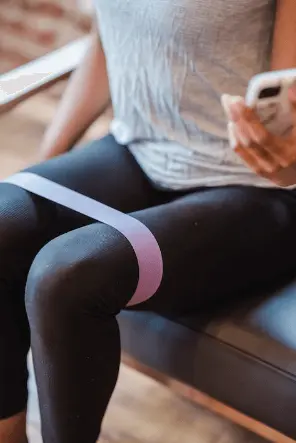Introduction
Resistance bands are a wonderful method to push your body and improve strength, whether you’re new to fitness or a seasoned veteran.
These bands start out light but can pack a punch when stretched deeper. As a result, they’re a better option than free weights because they’re gentler on your joints and tendons.
For your general health, strive for a balanced body in terms of strength, mobility, and flexibility. The bulk of us, however, have imbalances as a result of several modern-day lifestyle choices and can benefit from targeted exercise.
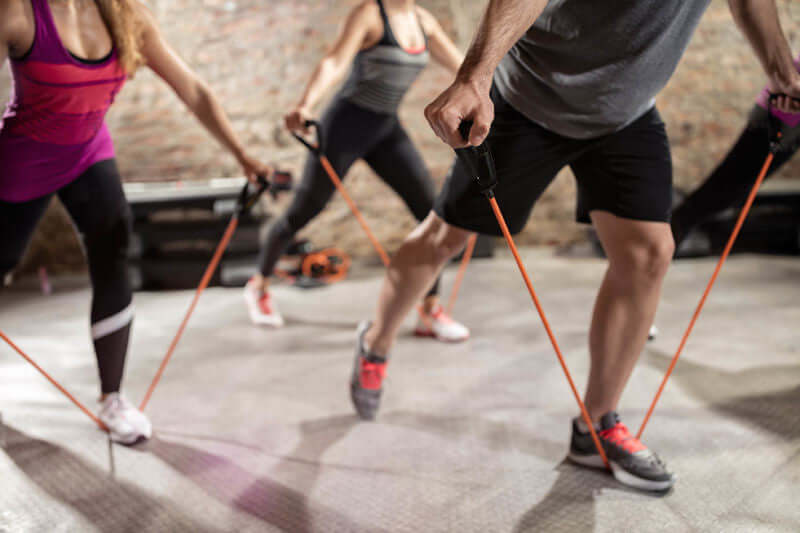
Our backside is more important than our front in several ways. Our backs keep us upright and capable of completing mundane to tough daily chores.
Fascial attachments connect all of your back muscles to your lower back. Keeping your back strong and flexible supports a healthy spine, less back pain, and good posture.
Benefits of resistance band workouts
Resistance band training is an excellent place to begin if you want to diversify your exercises, increase your strength, and promote functional fitness.
Resistance bands are appropriate for people of all ages and fitness levels. In fact, one study revealed that elastic-band resistance exercises can improve the balance, gait function, and flexibility of elderly people.
According to a scientific review, using this fitness device for resistance can produce the same strength gains as regular resistance training.
However, if you’re on the fence about including resistance bands in your workout routine, consider the following benefits.
- Resistance bands are available in a range of strengths, lengths, and sizes.
- They fold up, are portable, and are simple to store.
- They are among the least expensive pieces of fitness equipment available.
- Resistance bands can be used to perform gym-style exercises at home.
- During the concentric and eccentric phases of the workout, you will encounter resistance in both directions of movement (in other words, when both contracting and lengthening the muscle).
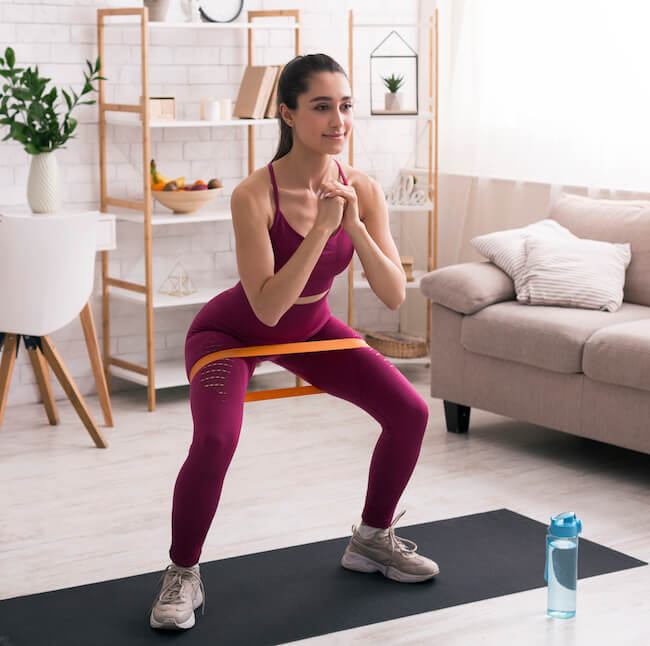
- The resistance can be changed to provide for a wide range of motion.
- With a resistance band, you may move in multiple planes and pull in various directions.
- Resistance bands lengthen the duration your muscles are stressed.
- Mini bands, loop bands, tube bands with handles, and flat therapeutic bands are all popular band kinds.
Here are 11 resistance band exercises that you can use to work your entire body!
A woodchopper
Woodchoppers are a terrific shoulder-strengthening exercise that also works the entire core, engaging the shoulder, abdominal, and quad muscles. Begin by placing one foot in the centre of the resistance band. Take both hands on one of the grips.
Place your hands near your knee in the starting position, clutching the handles. Begin to draw the handle across your body diagonally with your arms outstretched, with a slight bend in your knees.
Make sure you’re twisting your body by activating your abs and using your obliques. The point of no return is just over your opposite shoulder. Return to the starting position slowly. Repeat 10 times on each side, then swap sides.
The triceps kickback
Place both feet, hip-width apart, on the resistance band. In each hand, take one of the handles. Keep your back straight while leaning forward with a hip hinge.
Turn your hands so that the palms are facing you. Tuck your arms into your sides and bend your elbows 90 degrees. Keep your elbows tucked in and push the handles back and up until your arms are fully extended. Return to your original starting place. Repeat 10 more times.
Overhead pull-apart
Take one handle of the resistance band in each hand. Allow the grips to drop and grip the actual band to remove slack if the band is long.
Your feet should be hip-width apart. Straighten your arms over your head, palms facing away from you. Make sure the resistance band has enough tension to make pushing your arms apart challenging, but not so much that you have to struggle to do it.
Keep your arms straight and pull the band apart and out to the sides until your arms create a “T” shape. Return to your original starting place. Repeat 10 more times.
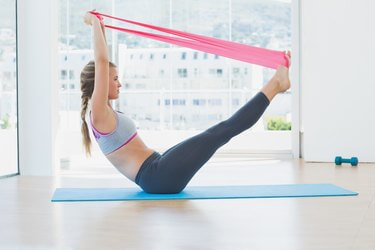
Pull-apart
Stand with your feet hip-width apart and one resistance band handle in each hand. Allow the handles to dangle and hold the genuine band if it is lengthy.
Extend your arms in front of you, palms down. Make sure the resistance band is tight enough to be a challenge but not so tight that it is difficult to separate.
Pull the band apart, forming a “T” with your arms, maintaining your hands and arms parallel to the ground. Return to your initial starting point. Repeat 10 times more.
Bent-over row
Place your feet on the resistance band, hip-width apart. Hold one resistance band handle in each hand, palms facing each other.
To tilt your body forward, bend your knees slightly and push your hips back. Maintain a flat back and an engaged core. Allow your arms to drop straight down beneath your shoulders, slightly bent at the elbows.
Drive your elbows straight up, keeping your elbows tucked into your sides, to lift the resistance band to your chest. Return to your starting point slowly. Repeat 10 times more.
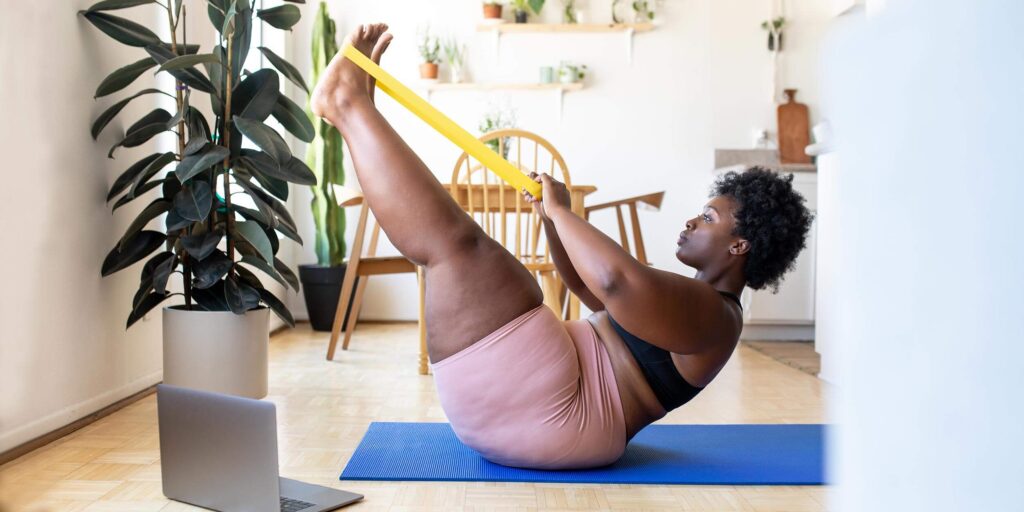
Bicep curl
Step onto the band with your feet hip-width apart.
Hold one handle in each hand with your arms at your sides. Draw your abs in and slightly bend your knees.
Pull the band up toward your shoulders in a bicep curl and release. Rep ten more times.
Overhead press
Begin by placing one foot in front of you, on top of the band, and the other foot behind you.
Change your grip, grabbing the handles from beneath with your hands pointing front and away from you. Start with the grips at shoulder height.
Pull the band up over your head with both arms fully extended. Return to the starting point and repeat 10 times more.
Standing side taps
This exercise targets the gluteus medius (the muscle outside the hip) and thighs. It’s also a cardio exercise because tapping from one side to the other without stopping raises your heart rate.
Step into the resistance band over your ankles. Draw your navel in toward your spine and bend your knees so that your buttocks extend back.
Spread your feet as far as your shoulders allow. This is a modified squat stance that you will maintain throughout the exercise!
Tap your right foot out to the right, feeling the band tension, and then bring it back to the centre so that the feet are as wide as the shoulders.
Then, tap the left foot to the left, feeling the stress on the band, and return it to the centre. Repeat for ten taps on each side.
Standing banded squat
Step both feet into the resistance band, wrapping it around your thighs a little above the knee. Step your feet out as far as your hips apart to apply tension on the band.
Sit back with your glutes, draw your navel in, and bend your knees. Drill your heels down to stand back up, as if you were sitting back in a chair.
The band’s pressure around the legs helps to engage the glutes and stabilise your body so you can properly execute the squat. Rep ten times more.
Standing lateral band walk
Step into the resistance band with both feet, wrapping it around your thighs slightly above the knee. Open the feet as wide as the hips to put stress on the band.
To get into a half-squat position, draw your navel in toward your spine and press down through your heels. Then shift your weight to your left side and execute a right-side step.
Bring your left foot in slightly, keeping tension on the band, and take 10 steps to the right (or however many steps you have room for!). Then repeat on the left.
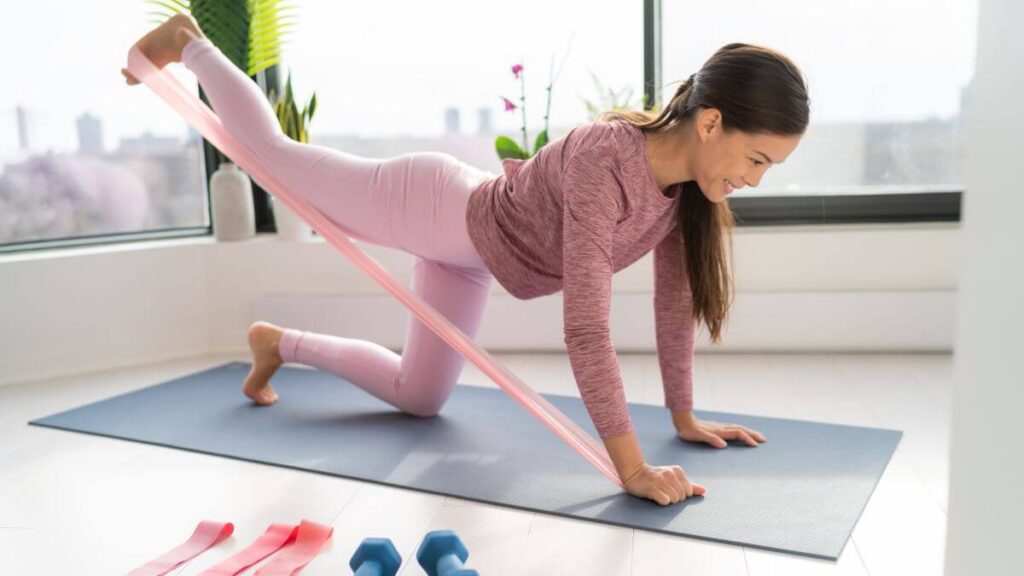
Banded bridge
Step both feet into the resistance band, wrapping it around your thighs a little above the knee. While resting on your back, bend your knees and spread your feet as wide as your hips.
The elastic should be wrapped around your thighs. Inhale deeply, then exhale as you draw your navel in toward your spine and tilt your pelvis forward, pressing your low back into the ground.
Roll your lower, middle, and upper backs off the ground slowly into a bridge posture, forcing your legs into the band and stretching them wide.
Maintain its position at the top. Then, pulse the legs and the band out to the sides for 10 counts. Slowly return to the ground, vertebrae by vertebrae. Rep ten more times.
Bird dog
The bird dog is an excellent technique to integrate into any workout. When performed correctly, it strengthens the lower back, glutes, core, and thighs.
Begin on your hands and knees, with your hands under your shoulders, your legs hip-width apart, and your resistance band wrapped around your quads.
Lift your left leg behind you while stretching your right arm forward and as high as it can go. For stability, feel resistance in your glutes and activate your core muscles.
Maintain a flat back and a tight core. Perform two sets of ten reps on each side.
To summarise
Incorporating resistance bands into your overall workout regimen is a simple, safe, and low-cost approach to challenge your muscles, develop strength, and combat boredom.
Resistance bands, as opposed to typical resistance training with dumbbells or barbells, allow you to maintain constant muscle tension while completing a manoeuvre.
Furthermore, getting started with this type of training is straightforward. You can do one or more of the programmes listed below, or combine a few moves from each to create a full-body workout.
These resistance band workouts’ versatility will surely keep you moving even when you don’t have access to a gym.
